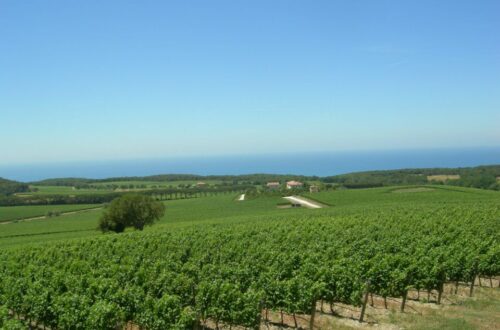Gavi / Cortese di Gavi DOCG: Piedmont’s Crisp White Gem
What is Gavi / Cortese di Gavi DOCG? Tucked into the gentle hills of southern Piedmont, Gavi DOCG—also known as Cortese di Gavi—is one of Italy’s most elegant and age-worthy white wines. Made exclusively from the indigenous Cortese grape, it’s known for its zesty acidity, mineral elegance, and citrus-blossom aromatics. Often overshadowed by the region’s famed reds, Gavi quietly asserts itself as one of Italy’s finest white wines, with a crispness and refinement that recalls fine Chablis.
History and Origins The roots of Gavi DOCG stretch back to the 17th century, when the Cortese grape was prized in the vineyards around the town of Gavi for its ability to retain freshness even in the summer heat. By the mid-20th century, Gavi had built a cult following among Italy’s northern elite, particularly in nearby Genoa, who sought a fresh, seafood-friendly white. The wine received DOC status in 1974 and was elevated to DOCG in 1998—making it the first white wine in Piedmont to achieve such prestige.
Where It’s Made: Geography & Terroir
The Gavi production zone is nestled in the southeastern corner of Piedmont, near the Ligurian border, in the province of Alessandria. Here, the vineyards benefit from a unique microclimate influenced by both the Apennines and sea breezes from the nearby Ligurian coast. The soils are primarily a mix of clay, marl, and limestone—ideal for expressing the minerality of the Cortese grape. This borderland terroir offers a dual identity: rooted in Piedmont’s winemaking discipline but kissed by the sea-loving soul of Liguria.
The Grape Cortese is a white grape native to Piedmont, cherished for its natural acidity, delicate aromatics, and resistance to disease. Gavi DOCG wines are made with 100% Cortese, making them a focused expression of this grape’s purity. While known for freshness and citrus, Cortese can also deliver nuanced orchard fruit, floral hints, and stony mineral depth.
Winemaking & DOCG Regulations To qualify as Gavi DOCG, the wine must be made from 100% Cortese grapes grown within the designated zone of 11 municipalities centered around the town of Gavi. The DOCG regulations allow for several styles:
- Still (Gavi Tranquillo): The most classic form, light and fresh
- Spumante: Sparkling Gavi, made using the traditional method
- Frizzante: Lightly sparkling, usually tank-fermented
- Riserva: Aged for a minimum of 12 months, including at least 6 in bottle, often showing more complexity and roundness
Key Facts at a Glance
- Region: Piedmont (Province of Alessandria)
- Grape Variety: 100% Cortese
- DOCG Status: Granted in 1998
- Styles: Still, Spumante, Frizzante, Riserva
- Alcohol Minimum: 10.5–11.5% depending on style
- Climate Influence: Maritime (from Liguria) and Alpine
- Soils: Clay, marl, limestone
Tasting Notes Expect a pale straw color with greenish highlights. On the nose, Gavi typically offers notes of white peach, citrus zest, green apple, acacia flower, and wet stone. On the palate, it’s dry, crisp, and mineral-driven, with vibrant acidity and a lingering finish that may show hints of almond or saline. More serious Gavi—particularly Riserva bottlings—develop honeyed, nutty, and savory notes with age.
Serving & Pairing Gavi is a natural partner for seafood thanks to its acidity and subtle saline quality. Ideal with grilled prawns, branzino, or fritto misto. It also pairs beautifully with:
- Fresh goat cheeses
- Pesto alla Genovese (a Ligurian classic)
- White risotto with lemon zest
- Sushi or sashimi Serve chilled at 8–10°C (46–50°F) in a white Burgundy glass to appreciate its aromatics and texture.
Where to Buy & Pricing Cortese di Gavi DOCG is widely available internationally, particularly from reputable importers specializing in Italian wines. Expect to find solid quality Gavi starting at $15–20 USD. Riserva and single-vineyard bottlings from top producers like La Scolca, Broglia, and Villa Sparina may retail at $30–60. In Italy, these wines are commonly found in enotecas across Piedmont and Liguria, often listed by the glass in seafood-forward restaurants.
FAQ on Gavi / Cortese di Gavi DOCG Is Gavi the same as Cortese? Cortese is the grape variety; Gavi is the appellation. Wines labeled “Cortese di Gavi” or “Gavi DOCG” are made from Cortese grapes grown in the Gavi zone.
What does Gavi taste like? Gavi is light-bodied, dry, and zesty, with notes of green apple, lemon, and mineral. It’s often compared to Chablis for its finesse and acidity.
Is Gavi DOCG age-worthy? Yes. While most are meant for youthful drinking, Riserva and well-crafted versions can age 5–10 years, developing more texture and savory depth.
What’s the difference between Gavi and Gavi di Gavi? “Gavi di Gavi” refers specifically to wines made from grapes grown in the comune of Gavi itself—the heart of the DOCG zone.
Fun Facts & Cultural Notes
- Gavi has long been a favorite white wine for Ligurian seafood lovers and Genoese traders.
- The town of Gavi sits near ancient trade routes between Genoa and northern Italy, explaining its cross-regional appeal.
- Gavi di Gavi has become a popular term internationally, though it’s technically just a subzone.
- Some producers experiment with aging Gavi in amphora or on lees to add complexity—giving the wine a new wave of boutique credibility.
CTA for Audience Engagement: Have you tried Gavi DOCG? Share your tasting notes or favorite pairings in the comments—or tag us in your Gavi moments @DrinkItalianOfficial. For more insider guides to Italy’s best white wines, [join our newsletter here].
Internal Linking Suggestions:
- Link to Piedmont Wine Region Guide
- Link to Italian White Wines Overview
- Link to La Scolca Gavi dei Gavi Wine Profile
- Link to Best Wines to Pair with Seafood
External Linking Suggestions:
- Consorzio Tutela del Gavi
- Wine-Searcher Gavi DOCG
- Italian Wine Central: Gavi DOCG


